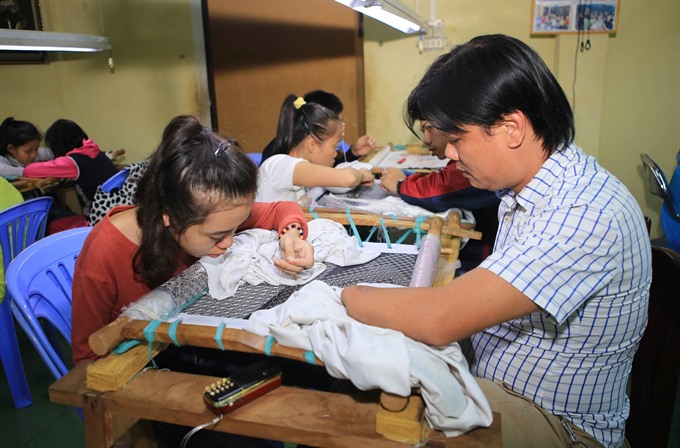 Society
Society

Over seven per cent of the population aged 2 years and older, or around 6.2 million people in Việt Nam, have a disability, according to the first National Survey on People with Disabilities which was launched in Hà Nội yesterday.
 |
| Students learn to embroider at Thừa Thiên Huế Province Vocational School for People with Disabilities. Only 7.3 per cent of the disabled aged 15 years or older are offered vocational training courses, the first National Survey on People with Disabilities revealed. — VNA/VNS Photo Hồ Cầu |
HÀ NỘI — Over seven per cent of the population aged two years and older, or around 6.2 million people in Việt Nam, have a disability, according to the first National Survey on People with Disabilities which was launched in Hà Nội yesterday.
Conducted by the General Statistics Office (GSO) in 2016 and 2017 with UNICEF’s technical assistance, this survey marked the first time that Việt Nam has undertaken a large-scale survey using tools based on international standards on disability measurement.
“The purpose of the survey was to assess the disability status of the population, and to evaluate their socioeconomic conditions to inform evidence-based planning and policies for improving the lives of adults and children with disabilities in Việt Nam,” said GSO Deputy Director Vũ Thanh Liêm.
The survey found that disability is both a cause and a consequence of poverty. Findings from the survey show that households with disabled members tend to be poorer than the national average, and children with disabilities attend school less and adults with disabilities are more likely to be unemployed.
While they are well covered by health insurance, and poverty does not appear to be a barrier to accessing health clinics, few persons with disabilities (2.3 per cent) use rehabilitation services when sick or injured. Gaps also exist in living standards and the social participation of people with disabilities.
The survey highlighted that the most common type of impairment for children is psycho-social related. This is connected to the different development stages of childhood and adolescence, and such impairments can act as a significant barrier to children’s social inclusion.
“More needs to be done to make early identification, intervention and community-based rehabilitation services widely available and accessible, and to improve the provision of social services to children with disabilities, so that they can reach their full potential and fully participate in their communities and in wider society,” said Lesley Miller, Acting UNICEF Representative.
The survey also indicated that children with disabilities have less access to education than their peers without disabilities. The gap is wider at higher levels of education. Less than one-third of children with disabilities go to upper secondary schools, compared to nearly two-thirds of children without disabilities.
Although there have been some positive results in mainstreaming children with disabilities with other children, only two per cent of primary schools and lower secondary schools have facilities that meet the needs of children with disabilities and only one in seven teachers received training on disabilities.
There is a remarkable difference in vocational training, according to the survey. Out of every 100 people with disabilities aged 15 years or older, only seven people are trained in vocational secondary schools (or 7.3 per cent) while this number for non-disabled people is 22 (or 21.9 per cent).
The survey also reveals that people with disabilities need to work for income and their independent livelihood but less than one third have a job.
Regarding social protection, the Government has made great efforts to support people with disabilities and out of every 10 people with disabilities, 4 people receive a monthly allowance; one in every two receives support to purchase health insurance cards and one in three is exempted from medical expenses.
Lesley Miller, Acting UNICEF Representative, stressed that the national survey represented a key element of Việt Nam’s commitment to the realisation of the rights of people with disabilities.
“With sound data, policymakers can assess the role that environmental factors, such as societal attitudes and physical barriers, have on the experience of people with disabilities. Importantly, data helps inform policies and programmes, facilitate the planning and monitoring of social services, and improve the participation and quality of life of people with disabilities and their families,” she said.
She noted that the Việt Nam Survey is one of the first national disability surveys in the world to use international standard tools, particularly the module for measuring disability among children.
“The survey is of great significance, particularly in the context of Việt Nam’s implementation of its national sustainable development agenda, which puts a focus on ‘leaving no one behind’,” she said.
Craig Chittick, Australian Ambassador to Việt Nam said: “The results of this survey provide a high-quality baseline for measuring progress in realising the rights of persons with disabilities and ensuring better access to services and education.”
The survey is one of the first national disability surveys in the world that incorporates both the Washington Group (WG) Extended Set of disability questions for adults and the UNICEF/Washington Group Child Functioning Module (CFM) for the identification of persons with disabilities via a survey.
It was carried out on 35,442 households in 658 out of 713 districts of all provinces and cities of the country. — VNS




